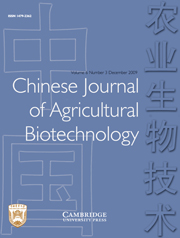No CrossRef data available.
Article contents
Isolation, cloning and sequence analysis of differentially expressed genes in the backfat tissue between hybrids and parents in pigs
Published online by Cambridge University Press: 12 February 2007
Abstract
In order to reveal the molecular basis of heterosis, Large White (LW), an introduced European pig breed, and Meishan (MS), a Chinese indigenous pig breed, were selected to hybridize directly and reciprocally in the present experiment. mRNA differential display (DD) technique was performed to identify genes that were differentially expressed in the backfat tissues of hybrids (LW×MS, MS×LW) and purebred (LW×LW, MS×MS) pigs. The ten anchor primers in combination with ten arbitrary primers (100 sets in total) were used and nearly 1500 reproducible bands were observed in polyacrylamide gels. The 40 differentially displayed bands were selected for cloning and sequencing. Thirty-six out of 40 expressed sequence tags (ESTs) proved to be novel and the sequences were submitted to GenBank (accession No. CV507051-CV507087); the other four showed similarity to known genes published in GenBank. Three among 36 novel ESTs were chosen for further identification with semi-quantitative reverse transcriptase polymerase chain reaction (RT-PCR). The result showed that two ESTs were differentially expressed, and the third showed no obvious difference between hybrids and purebreds. In order to reduce the percentage of false-positive DD, RNA pools of four types of pigs were constructed, by mixing samples from six pigs of the same genotype, and subjected to DD. Stringent annealing temperature was applied and only bands that could be repeated in duplicate PCR were used for further study. The results showed that the expression pattern of these 36 ESTs differed among the four genotypes of pigs, suggesting that the genes corresponding to these differentially expressed ESTs might be related to the heterosis occurring in fat tissue.
- Type
- Research Article
- Information
- Copyright
- Copyright © China Agricultural University and Cambridge University Press 2006


